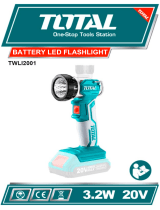
4
(2) Avoid storing battery cartridge in a container with
other metal objects such as nails, coins, etc.
(3) Do not expose battery cartridge to water or rain.
A battery short can cause a large current flow,
overheating, possible burns and even a breakdown.
13. If electrolyte gets into your eyes, rinse them out with
clear water and seek medical attention right away. It
may result in loss of your eyesight.
14. Be careful not to drop or strike battery.
15. Do not incinerate the battery cartridge even if it is
severely damaged or is completely worn out. The
battery cartridge can explode in a fire.
CAUTION:
1. When the tool is not in use, always switch off and
remove the battery cartridge from the tool.
2. Do not store the tool and battery cartridge in locations
where the temperature may reach or exceed 50 °C
(122 °F).
3. Do not give the tool a shock by dropping, striking, etc.
4. Do not expose the light to eyes continuously. It may
hurt them.
5. Do not cover or clog the lit tool with cloth or carton,
etc. Covering or clogging it may cause a flame.
6. Do not disassemble the charger or battery cartridge;
take it to a qualified serviceman when service or repair
is required. Incorrect reassembly may result in a risk
of electric shock or fire.
7. Use the tools only with specifically designated battery
packs. Use of any other battery packs may create a
risk of injury and fire.
8. When battery pack is not in use, keep it away from
other metal objects, like paper clips, coins, keys, nails,
screws or other small metal objects, that can make a
connection from one terminal to another. Shorting the
battery terminals together may cause burns or a fire.
9. If operating time has become excessively shorter, stop
operating immediately. It may result in a risk of
overheating, possible burns and even an explosion.
10. Do not use a damaged battery.
11. The contained lithium-ion batteries are subject to the
Dangerous Goods Legislation requirements.
For commercial transports e.g. by third parties,
forwarding agents, special requirement on packaging
and labeling must be observed.
For preparation of the item being shipped, consulting
an expert for hazardous material is required.
Please also observe possibly more detailed national
regulations.
Tape or mask off open contacts and pack up the
battery in such a manner that it cannot move around in
the packaging.
12. Follow your local regulations relating to disposal of
battery.
13. Use the batteries only with the products specified by
Makita. Installing the batteries to non-compliant
products may result in a fire, excessive heat,
explosion, or leak of electrolyte.
14. If any problem develops, consult your nearest Makita
Service Center or dealer. To maintain product safety
and reliability, repairs, maintenance or adjustment
should be carried out by Makita Authorized Service
Center.
SAVE THESE INSTRUCTIONS.
CAUTION:
Only use genuine Makita lithium-ion batteries. Use of non-
genuine Makita batteries, or batteries that have been
altered, may result in the battery bursting causing fires,
personal injury and damage.
Tips for maintaining maximum battery life
1. Charge the battery cartridge before completely
discharged.
Always stop tool operation and charge the battery
cartridge when you notice less tool power.
2. Never recharge a fully charged battery cartridge.
Overcharging shortens the battery service life.
3. Charge the battery cartridge with room temperature at
10 °C - 40 °C (50 °F - 104 °F). Let a hot battery
cartridge cool down before charging it.
4. Charge the battery cartridge once in every six months
if you do not use it for a long period of time.
FCC Cautions to the user
The changes or modifications not expressly approved by
the party responsible for compliance could void the user’s
authority to operate the equipment.
The equipment has been tested and found to comply with
the limits for a Class B Digital Device, pursuant to part 15
of the FCC Rules. These limits are designed to provide
reasonable protection against harmful interference in a
residential installation.
This equipment generates, uses and can radiate radio
frequency energy and, if not installed and used in
accordance with the instruction, may cause harmful
interference to radio communication.
However, there is no grantee that interference will not
occur in a particular installation. If this equipment does
cause harmful interference to radio or television reception,
which can be determined by turning the equipment off and
on, the user is encouraged to try to correct the
interference by one or more of the following measures:
– Reorient or relocate the receiving antenna.
– Increase the separation between the equipment and
receiver.
– Connect the equipment into an outlet on a circuit
different from that to which the receiver is connected.
– Consult the dealer or an experienced radio/TV
technician for help.
CAN ICES-005(B)/NMB-005(B)
FUNCTIONAL DESCRIPTION
Charging
Charge the battery cartridge with the Makita charger
before use.
This device complies with Part 15 of the FCC Rules.
Operation is subject to the following two conditions:
(1) this device may not cause harmful interference, and
(2) this device must accept any interference received,
including interference that may cause undesired
operation.





